Le
Mans 24 Hours 2008
First Day's Qualifying - Wednesday June 11th 2008
Wednesday
Qualifying
First
Session
It
had already been a long hot day even before the first hesitant
notes of race engines being fired up in the pitlane signalled
the impending start of the first qualifying session for
the 76th running of the Le Mans 24 Hours. Although not quite
as stifling as Tuesday had been, Wednesday’s sunshine
was just as bright, and the combination of a warm track
and a light breeze suggested that some very quick times
might be possible after all. In the past, fast times set
in the official test have often not been repeated when the
tenths really mattered, but the prediction was that 2008
would see a different trend.
By
five to seven, those keen individuals who’d started
blipping throttles ten minutes previously had been joined
at the pitlane exit by a long queue of other drivers, all
now eager to get started. An hour of practice for the Group
C support race had only recently drawn to a close –
and what a magnificent sight those cars are! – so
there was a fair chance that the track would be in better
condition than it had been for the start of that official
test on June 1st. With any luck, quick times would not be
long in coming.
Tommy
was not heading the queue, but he wasn’t far down
the order. The MG had been eased out into the pitlane for
refuelling at 6:54, and when the exit lights turned green
and the marshals waved their flags to signal the opening
of the track, the Brazilian was soon accelerating up the
hill towards the Dunlop Chicane. The sound of nearly fifty
cars heading out onto the track for the first time is a
very emotive one, made more so by the way the intensity
of that noise increases almost exponentially – just
one or two isolated engines breaking through the quiet of
the evening air at first, but then joined by more and more
as the rest of the cars stream out onto the rack. That wave
of sound then echoes through the trees, and can be followed
in the distance as the lead cars head down towards Mulsanne,
then break west for Indianapolis and Arnage, and finally
make that dogleg north once again to head back towards the
grandstands. As if channelled by the concrete walls of the
Porsche Curves, it doesn’t take the waved green flags
of the marshals at the Ford Chicane to confirm that the
first lap has been completed. The sound is enough.
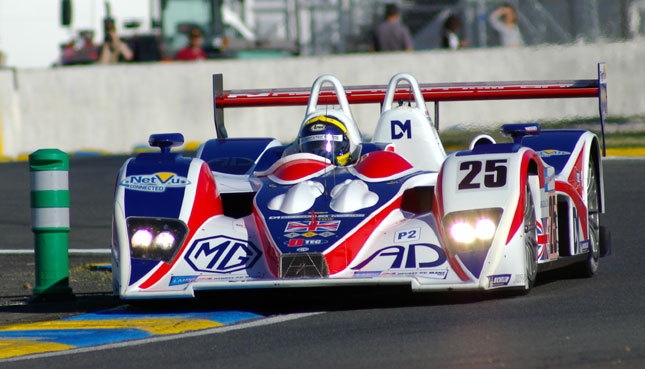
Keen
to make an impression, even this early in the day, a Peugeot
908 was the first to appear, slicing through the left-right-left-right
of the Ford Chicane at what is already astonishing speed,
followed in hot pursuit by the first of the Audis. It sets
a scene that will be repeated time and again, no doubt for
the rest of the week. Many of those to take to the track
at this early point in the evening head straight back down
the pitlane, but not Tommy and the MG. “Coming up
to the Ford Chicane” he says over the radio –
the final comment that confirms that pit-to-car communication
is intact throughout the circuit – and then the distinctive
red, white and blue Lola hustles into view. The RML MG becomes
the first of the LMP2 prototypes to complete a full lap,
and consequently, tops the class, at least for the time
being.
By
quarter past the hour nearly every one of the fifty-five
cars is out on the circuit. “There’s a lot of
traffic and the grip level is still quite low,” says
Tommy. He presses on for another lap before the instruction
comes over the radio from Phil Barker to “pit this
lap”. It’s 7:20. Asked if he thinks the car
is OK for Mike to get straight in, and needs no adjustment,
he confirms that the car feels good. A little understeer
perhaps, but fine for Mike to do his daylight laps.
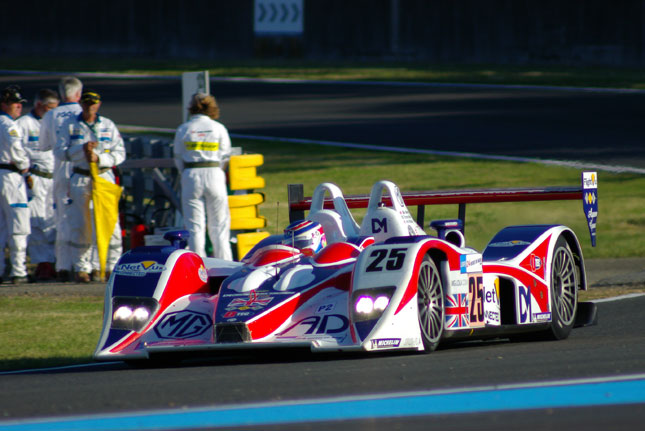
Three
minutes later Tommy headed down the pitlane, the car was
refuelled and fitted with new tyres, and Mike was strapped
into the cockpit and away. A parting comment from Phil reminded
Mike that the track was still very green, so he’s
to take care for the first few laps. It’s a warning
he heeds, of course, but is still caught out on both his
first two laps by the lack of grip at the entrance to the
first Mulsanne Chicane. “I straight-lined it both
time,” he grins later. Rather than forcing the car
round the loop, he weaved between the tyre-wall and rejoined
safely on the other side. It’s the only incident in
a trouble-free trio of laps, and he was back in the pitlane
by 7:51, where Andy was waiting to take over.
It
was not a driver-change at race speed of course, but Andy
was soon on his way with a final reminder to re-set the
fuel as he burbled out beneath the imposing new ACO building.
Heading down towards the far corners of the circuit he radioed
back to the team to complain about “oil everywhere,
particularly through Indianapolis”, although there
was no suggestion at the time as to who might be responsible.
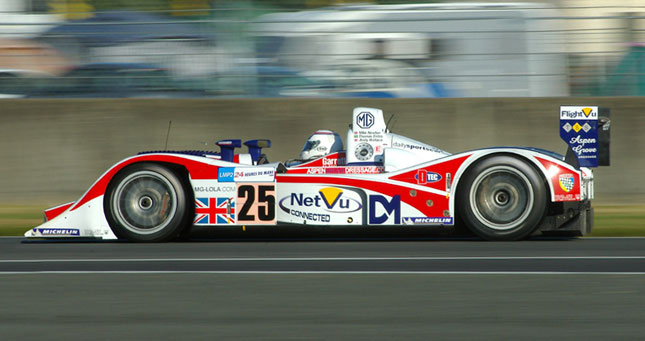
Andy
started his second lap – his first flyer, in effect
– and was blatting down the first section of the Mulsanne,
at full chat, when he went for the brakes to slow for the
first chicane – Playstation. It was the same place
where Mike had elected to take the straighter route, but
Mike had done it heading forwards. “I just put my
foot on the brakes, and the next I knew, I was going full
speed backwards!” The car had done a full 180-degree
spin, and Andy, the MG, and the Armco were about to meet
at nearly 150 miles an hour. “There was less than
a second between touching the brakes, and hitting the wall.
I remember thinking, what the ***** was that!!” The
rear left corner of the car hammered into the steel barrier,
where photographer Gabriel Portos was leaning on the rail
with a long lens fitted to his Canon – too long to
get a shot, but enough to make sure he stepped back smartly
when the MG struck. A nearby marshal, looking the other
way, was caught of guard and spun round in alarm as the
Armco bowed towards him.
Andy
was unhurt, and clambered out of the car to inspect the
damage. Would it drive back to the pits? He thought not.
“The rear corner is hanging off!” he declared.
“It’s impossible to drive, and if I tried, I’d
probably just do a lot more damage.” So it was ‘session
over’ for the MG, and despite efforts by the team,
there seemed no way that anyone could get out to collect
Andy. He had to wait with the car until the chequered flag
at nine o’clock, and then hitch a lift back to the
garage.
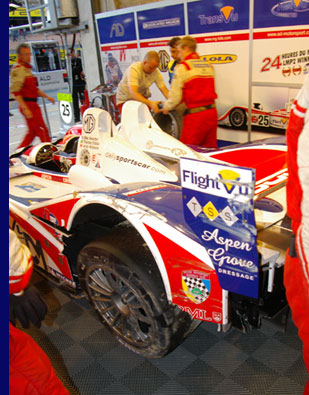 The
car was a sorry sight, but not as bad as some mental pictures
painted in the minds of the crew. Damaged bodywork hung
from the rear left, shards of shattered carbon fibre flapping
loosely over the tyre, the wheel itself hanging at an impossible
angle. There was no hesitation from the experienced RML
crew, who leaped instinctively into action, tearing off
the useless panels, undoing nuts and bolts, and removing
the entire sub-assembly from the rear left corner. It was
a major challenge, and with the car not back until almost
half the hour-long break had elapsed, the MG would be missing
the opening period of the second session – often the
best in terms of track conditions. “The car felt so
good,” said Tommy. “I couldn’t fault it.
The grip level from the track was a bit low to begin with,
and the car felt loose because of that, but there was good
balance. In fact, it felt so good that I was very happy
to hand the car straight over to Mike. I knew the rack would
get better, so I was confident he’d have a good run.
The
car was a sorry sight, but not as bad as some mental pictures
painted in the minds of the crew. Damaged bodywork hung
from the rear left, shards of shattered carbon fibre flapping
loosely over the tyre, the wheel itself hanging at an impossible
angle. There was no hesitation from the experienced RML
crew, who leaped instinctively into action, tearing off
the useless panels, undoing nuts and bolts, and removing
the entire sub-assembly from the rear left corner. It was
a major challenge, and with the car not back until almost
half the hour-long break had elapsed, the MG would be missing
the opening period of the second session – often the
best in terms of track conditions. “The car felt so
good,” said Tommy. “I couldn’t fault it.
The grip level from the track was a bit low to begin with,
and the car felt loose because of that, but there was good
balance. In fact, it felt so good that I was very happy
to hand the car straight over to Mike. I knew the rack would
get better, so I was confident he’d have a good run.
Indeed,
Mike’s run had gone well, and the CEO of AD Group
had been comfortable with the feel and precision of the
MG. Quite what caused Andy’s spin remains a mystery.
“I have absolutely no idea what happened,” h
said, a crestfallen look upon his face. He and Tommy recalled
the occasion, back in 2005, when the rear suspension broke
on the EX264 with only a few hours of the race left to run.
On that occasion it was easy to trace the problem, and as
luck would have it, the accident happened at the Ford Chicane,
and Tommy had been able to get the car back to the pits,
where it was repaired and went on to win the class. This
time there had been no such obvious cause, and Andy’s
bewilderment remains.
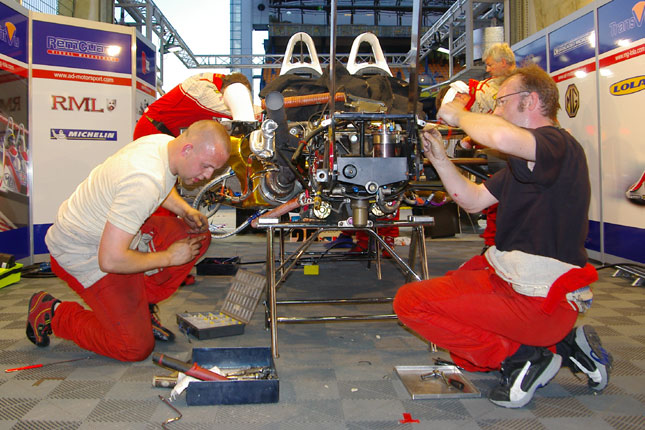
Effecting
the repair took about an hour and a lot of spare parts.
The complete under floor, both front and rear, had to be
replaced, as well as the entire rear left subassembly, including
hub, driveshaft and all suspension components. The bodywork
had suffered badly, with the engine cover, side pod, rear
wing and wing uprights all needing replacements. “It’s
very expensive damage for us,” said Phil Barker. “Our
insurance broker will be getting a call in the morning!”
It was hard to tell if he was joking.
Second
Period
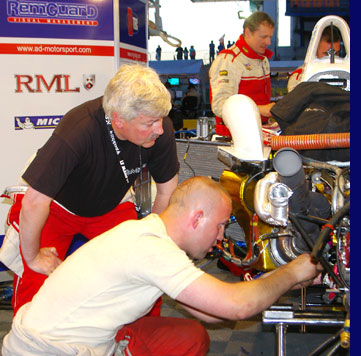 So
the evening’s session resumed at ten without RML’s
MG. As predicted, a string of quick times came almost immediately,
with Maassen taking top honours in LMP2 for the #31 Porsche,
followed soon afterwards by Verstappen in the #34, both
bettering Verger’s pre-break time in the Barazi Zytek.
Then, with another half an hour gone, the first red flag
of the night.
So
the evening’s session resumed at ten without RML’s
MG. As predicted, a string of quick times came almost immediately,
with Maassen taking top honours in LMP2 for the #31 Porsche,
followed soon afterwards by Verstappen in the #34, both
bettering Verger’s pre-break time in the Barazi Zytek.
Then, with another half an hour gone, the first red flag
of the night.
The
Modena Aston Martin had hit problems in the Porsche Curves,
but it was the following Pescarolo #16 which hit the walls.
Caught out by the oil left on the track by the Aston, Dumas
was first on the scene, and in the failing light had no
warning that the track was smeared with the fresh fluid.
The fastest petrol-engined car of the session was suddenly
exchanging blows with the unforgiving concrete, and destroying
both front and rear in the process. Luckily Dumas was unhurt,
and was even able to jog back to the pitlane, but the car
was less fortunate. Recovering the remains took almost half
an hour.
At
11:06 the session resumed, and this time the MG was ready.
Tommy went out first, and successfully completed his minimum
three-lap night-time requirement, content to set times in
the low fifty-threes. Mike went next, heading out at 11:20
with strict instructions to do one timed lap and then back
in the box. Aside from observing that the car had a throttle
pedal “like a hair trigger” that was later attributed
to a broken spring, he had a problem-free run, handing over
to Andy who also completed his three laps and was back in
the garage by 11:50.
It’s
unlikely the MG would have gone out again anyway, but within
a minute the red flags were flying. Hideki Noda in the Kruse
Lola had endured an horrific accident on the run through
the Dunlop Curve. The car did not appear to catch anything,
but a dab on the brakes must have been enough to lock the
rear wheels, tipping the car sideways at speed. On the rise
up the hill, there must have been just enough lift for the
air to get under the skirts, and instantly, the Mazda-powered
Lola was airborne. In a frightening succession of barrel
rolls and flick-flacks, the car tumbled up the hill in a
rain of debris and flailing cables, body parts and loose
wheels. Amid a stunned silence, the car finally came to
a halt; Noda slumped in the cockpit, but the right way up.
The marshals were there in moment, and the session was stopped
immediately. Once again, a prototype had gone airborne.
Andy
had just been thanking the team, over the radio, for the
excellent way they had put the MG back together when the
news reached the pitlane. There was an immediate realisation
that what has just happened to Noda could so easily have
happened to Andy during his earlier spin. “It’s
not nice to be that close to the edge,” he mutters.
Brightening quickly, he adds; “The guys did a lovely
job in putting the car back together – they’re
totally brilliant. The car’s as good as gold again.”
In fact, Tommy was prepared to go further, and suggest it
actually felt better.
In
the end, despite the delays, RML completed their day’s
schedule successfully. “We qualified all the drivers,”
said Phil Barker, “and that was Plan B. Everything
had been going largely to plan before Andy’s incident,
but after that, any thoughts of doing fast times went out
the window. It was then more important to see the drivers
properly qualified. Damage limitation, in a way, but if
the weather holds, we can have another go tomorrow.
Please
visit the high
resolution gallery
for images from Le Mans 2008
